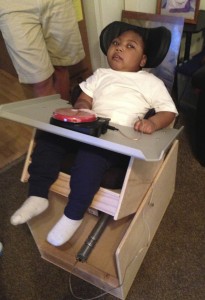Designers: Albert Chang, Michelle Meng, Josh Neiser
Client Coordinators: Karen Tartick, PT, and Debra Monnin, OTR/L
Supervising Professors: Kevin Caves and Richard Goldberg
INTRODUCTION
Our client Joe is a three-year-old child with cerebral palsy. Joe presents many common complications of cerebral palsy including movement impairment and spasticity in his limbs, poor oral motor control and cognitive impairments. As a result, he is non-verbal and requires a wheelchair for mobility. He has significant postural instability and requires a brace for corrective support. When placed in a seated position, he also requires neck and lateral support. Although he is non-speaking, he indicates his likes and dislikes through smiling and crying.
Joe spends most of his waking time either lying on his stomach or sitting in his custom-built wheel chair. A favorite activity is when he sits upright in his therapist’s lap, who bounces him while singing or playing a recorded song. Joe enjoys this motion but he is dependent on an adult for this activity. As a result, Joe needs a device that will allow him to independently activate a bouncing motion in the seated position.
STATEMENT OF IMPACT
Karen Tartick, PT said: “Joe loves movement, and smiles when he is bounced and rocked. This device will greatly improve Joe’s quality of life. He will be able to independently provide himself a rocking movement when he activates a switch with his hand. Joe will no longer have to be dependent on adults, who may be busy, and once positioned in the rocker chair, will learn that he is capable of independent and fun movement. Joe’s family will also greatly benefit, as they will be able to see Joe smile and laugh, as they work about the house.”
TECHNICAL DESCRIPTION
The device consists of a base that holds a motor and cam that bounces a seating system that provides supports for Joe while in use (Figure 1). Joe can activate the motion independently by pressing a switch with his hand or head. The device is designed to be used with an Ablenet Talking BigMac switch that has auditory and switch output capabilities. When pressed, the BigMac switch will play a recorded message (currently his grandmother singing a bounce-bounce song), and also turn on the bouncing motion. The device is comprised of 3 primary components: the chair and base, the motor and cam, and the electronics.
The chair and base are constructed from 1/2 inch hardwood plywood. The chair is attached to the base via a pair of 5/16 inch machine bolts that allow the chair to pivot to make the rocking or bouncing motion. The chair holds a custom seating system that can be adjusted when Joe grows. The base has castors to allow easy movements. A tray was constructed to clip onto the sides of the chair with simple metal clamps.
Off the backrest of the chair is a wooden arm with a roller wheel at the bottom. The roller rests on an oblong cam attached to a conveyor belt motor (Figure 2). As the motor rotates the cam pushes up on the backrest of the chair, causing the chair to “rotate” about the pivot. The cam is made from Delrin plastic, which is strong and durable. To prevent the wheel from slipping off the cam, the wooden arm is kept in place using a wooden frame with low-friction wheels.
The motorized roller (PM486FP) and control card (CB- 008), both manufactured by Itoh Denki, provide an easy to use, high-torque motor. We have implemented a simple power source that provides plenty of power for our application. One end of an eighth inch audio cord plugs into the front of the device while the other end plugs into the back of the chair. When pressed, the button switches to the “on” state, which plays an audio recording and delivers power to the roller for the duration of the recording. Once the recording is over, the button is switched back to the “off” state and the roller stops turning. An emergency stop plug was installed on the side.
The total cost of this device is $300.

